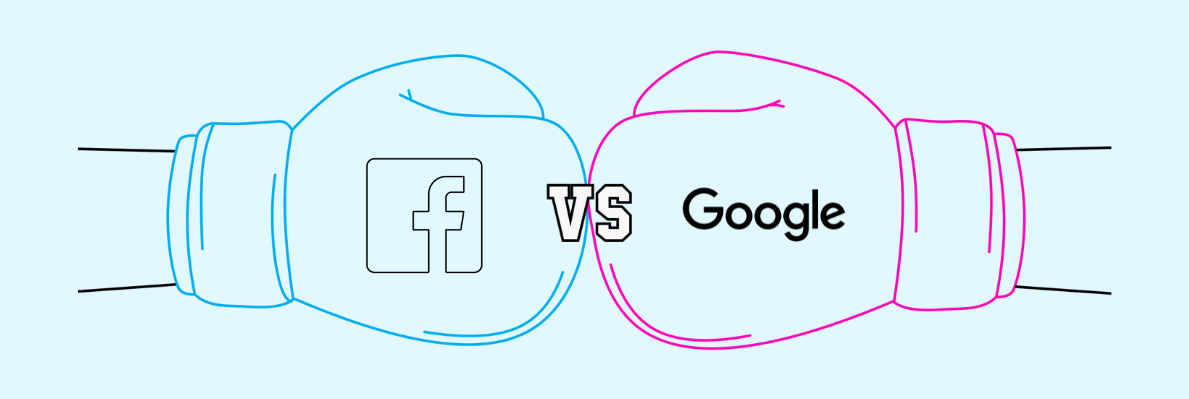You’d also be forgiven for thinking that there’s been a long-standing rivalry and direct competition between the two advertising platforms, forcing you to choose between one or the other. But in recent years, the platforms have gradually focused on different features, and the notion that the two ad platforms are competitors couldn’t be further from the truth, practically.
But as a result, it begs the questions of: “Which is better? How do they work? Which do I choose? Can I use both together?”
So, in this article, we’ll take you through an in-depth analysis of Google Ads and Facebook Ads, each platform’s unique features and differences, and how to choose which is right for you.
Facebook Ads vs. Google Ads - The TLDR version!
Facebook Ads is an advertising platform used for paid social ad campaigns directly on Facebook, Instagram and Messenger, whereas Google Ads is used for a number of ad formats, including search, display and video ads.
Whilst both are forms of paid advertising, they are very different in nature. Google Ads focuses on keywords or Google partner site placements, whereas Facebook is more directed towards specific audiences based on demographics, interests and behaviours.
Despite their differences, an omni-channel approach could work for your business, dependent on what you're providing and who you're providing it to
Facebook Ads in more detail
If you asked a marketer to describe “paid social”, they would most likely begin to describe Facebook Ads. With more than 2 billion people using Facebook every month, and nearly 1.7 billion users every day, Facebook has become a lucrative platform in business’ digital marketing arsenal.
Facebook Ads come in several varieties. You can promote your page, specific posts on your page, or your website itself. Whilst Facebook is increasingly focused on native ads and keeping traffic on its own site, you can still run ads successfully that sends users to your own website. Other ads formats include images, videos, carousel, Instant Experiences and more.
Unlike Google Ads, Facebook Ads do not use keywords, and instead ads are created and displayed based on interests, and how the user interacts and behaves online. You can go into granular detail when targeting, basing your target audience on location, demographic, profile information and more.
As such, Facebook ads can be a great way of engaging with your target audience, building brand awareness and even driving sales through your business. Users should focus on a small-value conversion, such as a newsletter signup, as done successfully by the likes of Groupon and AppSumo.
Google Ads in more detail
Google Ads (formally Google AdWords) is the world’s largest and most popular PPC advertising platform, and for good reason. With over 5 billion searches per day, Google is often the first place people go to with a query, using search engines to help them make informed buying decisions, so it’s no wonder businesses want to tap into that pool of searches to convert more people!
Search Ad campaigns are driven by keywords, where advertisers bid on specific words and phrases used in search queries by users of Google, with a view to the ad appearing alongside search results for those queries. Depending on the strategy chosen, each time a user clicks on an ad, the advertiser can be charged a certain amount of money for the click, but it’s important to remember that there are other methods of billing the advertiser too.
Google Ads has rapidly evolved to encompass a variety of different ad types. The “standard” ads are search-based, as described in the last paragraph, but advertisers can also create:
- Display ads - image ads on websites that are part of Google Display Network.
- Video ads - using websites such as YouTube.
- Shopping ads - displayed as product listings on Google.
Each ad type will bring different levels of success to different types of businesses. For example, a service-led business is unlikely to have any success with shopping ads, whereas an online or physical store could see an astronomical click-through rate on shopping ads when utilised correctly.
The strengths and advantages of Facebook and Google Ads
In addition to the features highlighted earlier, there are a number of strengths and advantages to both Facebook Ads and Google Ads, either separately or together. Let’s look at a few in more detail:
Facebook Ads
One of the shining star features of Facebook Ads is the ability to go into much more granular detail with audience targeting, allowing you to reach users based on demographics, behaviours, life events, interests and more.
A flagship feature that is a major advantage over Google Ads is, when launching a campaign, being able to create a “lookalike audience”. This feature allows you to create a version of your user (or buyer) personas, and then show your ads to audiences who match this description.
Another advantage is that Facebook Ads tend to generate a higher clickthrough rate. Data from Smart Insights suggests that the average CTR for Facebook Ads was 1.11%, compared with just 0.47% for Google Display ads in the same period.
Google Ads
The biggest strength of Google Ads is the immense audience size. With over 40,000 search queries every second, no other search engine can offer the potential audience that Google can.
As such, it’s incredibly easy to deliver a return on investment for brands, with WebFX reporting that the average return on ad spend is 200% (e.g.: for every $1 spent, you earn $2). Better still, the average ROI for Google Search Network only is 800%!
With this in mind, you might be thinking “the more money you have, the better your ads are going to perform” which is a huge misconception, and that’s because Google Ads focuses on the quality and relevance of ads and keywords, not how much you spend. Yes, certain keywords are more expensive, but how much advertisers have to bid will largely depend on the quality score, which is calculated based on Click-through rate (CTR), Ad Relevance and Landing Page Experience.
One final strength of Google Ads is remarketing. This allows you to retarget users who have interacted with your brand before, which can provide massive opportunities for influencing the purchase decision, and re-engage with users on a different platform. Remarketing can also be done in Facebook Ads, and is not a feature or benefit exclusive to Google Ads, but that doesn’t discount it as a fantastic feature of Google Ads nonetheless.
Choosing the platform that’s right for you
When planning your marketing efforts, if you only plan to focus on one platform, here are a few things to consider:
Goal of your campaign
As discussed so far, Facebook Ads and Google Ads can do very different things, which is why the first thing you should do when considering which platform to choose is determine the goal of your campaign.
The could be brand awareness, lead capture, sales, or something else.
Google Ads is well suited to demand capture - a user knows what they are looking for and are researching the product/service further; and users with a high purchase intent.
Meanwhile Facebook Ads are great for brand and product awareness, targeting those at the top of the funnel. If a graphic or messaging is compelling enough, it can also perform well in terms of sales or engagement.
Your budget
Always do your research to see which platform could result in the best return.
With Google Ads, performing keyword competition research will help unveil which keywords are best to target for your budget. For instance, targeting keywords at £20 per click isn’t going to get you very far on a £100 daily budget, whereas keywords at £2 a day will perform much better.
Facebook can typically be a cheaper alternative to Google Ads, however, this is not always the case. It’s also worth ensuring that your audience is on Facebook/Instagram before diving into this advertising platform just because it can be cheaper.
Stages of the buyer journey
Your audience will undoubtedly be at different stages of the buyer journey when they interact with you or your ads. Think about what stage you want to target them and which platform is better suited for that buyer stage.
With Facebook being a social media platform, most users are not actively looking to purchase products, but the platform can still be used to gauge their interest. Whereas your audience performing high intent Google searches is likely to be at the bottom of the funnel, which is the prime time to capture them with an ad.
The competition
Intel on your competitors can help inform your strategy, especially if you’ve not performed any ads campaigns before.
Do your research, look at the ads they’re running, the messaging they are using and where they are running from. This can help inform not only what platform to use, but also what keywords and audiences to target.
The alternative: Using both platforms together
Whilst it is possible to have a great level of success using one platform only, using both together can create a two-pronged approach to your ads strategy, and provide double the reward. This of course is completely dependent on what you are providing and who you are providing it to.
Here are some ideas for how you can use both platforms conjunctively:
- If you have a Google ads campaign that is highly targeted, use Facebook to retarget those with high buying intent.
- Use data from your Facebook’s Interests and Behaviour to create a remarketing list in Google and apply it to your Ad groups.
- Show people who have searched your business’ location with retargeted location-based ads on Facebook.
How is your paid advertising performing?
It’s time to debunk the long-standing rivalry between Facebook Ads and Google Ads. Both platforms are great, and can bring fruitful results to businesses of all varieties.
If you need some direction or support with your ads campaigns, Selesti as a Premier Google Partner is primed to help. Talk to us about your ads strategy or social media marketing; we’d love to steer you on track!

